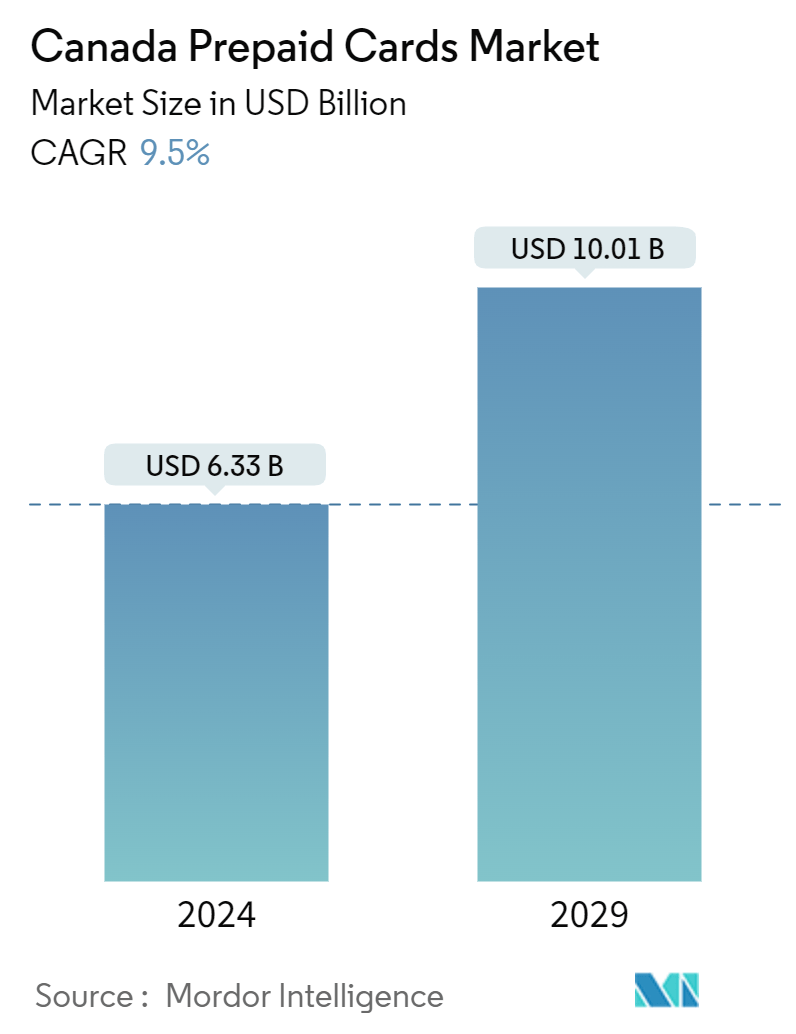Market Size of Canada Prepaid Cards Industry

| Study Period | 2020 - 2029 |
| Base Year For Estimation | 2023 |
| Market Size (2024) | USD 6.33 Billion |
| Market Size (2029) | USD 10.01 Billion |
| CAGR (2024 - 2029) | 9.50 % |
| Market Concentration | Medium |
Major Players
*Disclaimer: Major Players sorted in no particular order |
Canada Prepaid Cards Market Analysis
The Canada Prepaid Cards Market size is estimated at USD 6.33 billion in 2024, and is expected to reach USD 10.01 billion by 2029, growing at a CAGR of 9.5% during the forecast period (2024-2029).
Canada boasts a robust prepaid card market, with over 90 active companies. Notably, these prepaid companies represent a significant 1/6th of all payment technology firms in the nation, with the majority falling under the FinTech umbrella. The landscape sees a surge in new launches and innovations, particularly in Challenger Banks, Program Managers, and Service Providers, with Challenger Banks leading the pack in new FinTech entrants. Half of the 90 players in Canada's prepaid value chain are homegrown; 60% have their headquarters in Ontario.
Canada has witnessed a notable rise in kids' and teen banking in recent years. This trend empowers parents to efficiently allocate funds to their children, monitor their spending, assign tasks tied to allowances, and impart valuable lessons on savings. Real-time access to earnings facilitates swift transfers to prepaid cards, ensuring immediate usability. Furthermore, the country's cryptocurrency marketplaces are rolling out prepaid cards, streamlining funding, withdrawals, and expenditures.
The burgeoning prepaid industry in Canada brings many benefits, notably enhancing financial inclusion for the expanding gig economy and offering increased choice and convenience to all Canadians. Post-pandemic, online purchases and travel have emerged as leading purposes for prepaid card usage, complemented by a steady rise in debit card users, further propelling Canada's prepaid card market.
Canada Prepaid Cards Industry Segmentation
A prepaid card is a kind of payment card one can use to purchase or pay bills, such as credit cards or debit cards. Banks, financial institutions, and others issue these cards with loaded funds. Users can make a transaction without having to pay interest in the future.
Canada’s prepaid cards market is segmented by offering (general purpose cards, gift cards, government benefit cards, incentive/payroll cards, and other offerings), card type (closed-loop cards and open-loop cards), and end user (retail, corporate, and government). The report also covers the market sizes and forecasts for Canada’s prepaid card market in value (USD) for all the above segments.
| By Offering | |
| General Purpose Card | |
| Gift card | |
| Government Benefit card | |
| Incentive/Payroll Card | |
| Other Offerings |
| By Card type | |
| Closed-loop Card | |
| Open-loop Card |
| By End-user | |
| Retail | |
| Corporate | |
| Government |
Canada Prepaid Cards Market Size Summary
The Canadian prepaid cards market is experiencing significant growth, driven by a shift towards digital and contactless payment methods. This transition has been accelerated by the COVID-19 pandemic, which prompted a substantial portion of the population to prefer digital transactions over cash. The market is characterized by a diverse range of players, including Challenger Banks, Program Managers, and Service Providers, with a notable increase in FinTech entrants. The market's expansion is further supported by the growing popularity of prepaid cards among children and teenagers, as well as the integration of real-time earnings access. Additionally, the cryptocurrency sector is contributing to the market's growth by offering prepaid cards for easier transactions.
The gift card segment within the prepaid market is also thriving, fueled by the corporate gifting culture and innovative programs aimed at supporting local businesses post-pandemic. Open-loop prepaid cards are gaining traction, particularly in the gig economy and among neo banks, where younger consumers prefer app-based solutions. Major technology companies and e-commerce platforms are increasingly issuing these cards, enhancing their appeal and accessibility. The market is dominated by a few key players, but technological advancements and service innovations are enabling both domestic and international companies to expand their presence. Partnerships and new product offerings, such as digital gift card marketplaces, are further driving the market's growth and adoption.
Canada Prepaid Cards Market Size - Table of Contents
-
1. MARKET DYNAMICS AND INSIGHTS
-
1.1 Market Overview
-
1.2 Market Drivers
-
1.2.1 Rise in Demand for Alternative Cash
-
1.2.2 Rising Penetration of Internet Services Widening Prepaid Cars Scope
-
-
1.3 Market Restraints
-
1.3.1 Penetration Rate of Prepaid Cards Still Existing at a Lower Level
-
1.3.2 Lack of Security Measures In Prepared Card Compared to Credit and Debit Cards
-
-
1.4 Market Opportunities
-
1.4.1 Rising E-commerce Increasing Adoption Rate of Prepaid Card
-
1.4.2 Rise in Use of Contactless, Cost-effective, and Secured Cash Alternative Option
-
-
1.5 Industry Attractiveness - Porters' Five Forces Analysis
-
1.5.1 Threat of New Entrants
-
1.5.2 Bargaining Power of Buyers
-
1.5.3 Bargaining Power of Suppliers
-
1.5.4 Threat of Substitutes
-
1.5.5 Intensity of Competitive Rivalry
-
-
1.6 Technological Innovations in the Canada Prepaid Card Market
-
1.7 Impact of COVID-19 on the Market
-
-
2. MARKET SEGMENTATION
-
2.1 By Offering
-
2.1.1 General Purpose Card
-
2.1.2 Gift card
-
2.1.3 Government Benefit card
-
2.1.4 Incentive/Payroll Card
-
2.1.5 Other Offerings
-
-
2.2 By Card type
-
2.2.1 Closed-loop Card
-
2.2.2 Open-loop Card
-
-
2.3 By End-user
-
2.3.1 Retail
-
2.3.2 Corporate
-
2.3.3 Government
-
-
Canada Prepaid Cards Market Size FAQs
How big is the Canada Prepaid Cards Market?
The Canada Prepaid Cards Market size is expected to reach USD 6.33 billion in 2024 and grow at a CAGR of 9.5% to reach USD 10.01 billion by 2029.
What is the current Canada Prepaid Cards Market size?
In 2024, the Canada Prepaid Cards Market size is expected to reach USD 6.33 billion.

